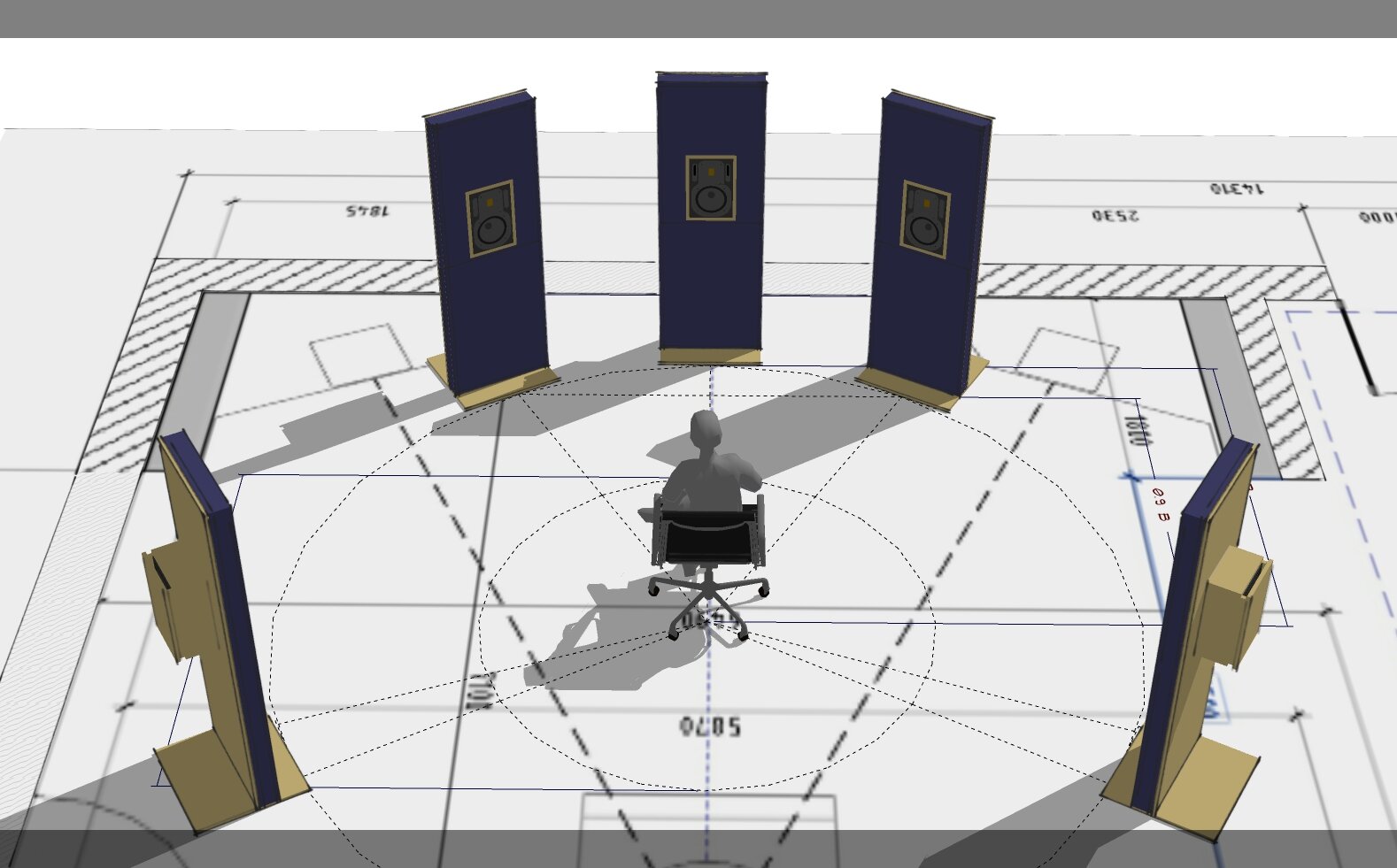-
Posts
2,297 -
Joined
-
Last visited
Everything posted by Glenn Stanton
-
is it the same underlying disk or a partition on the same disk as the OS? i recommend a separate physical disk because (esp if its a rotating disk drive) the access contention will be higher.
-
this is a rabbit hole ? i prefer the dome tweeters myself - i find the ribbons are too harsh for me. but i know a bunch of clients who have the ribbons and absolutely swear by them.
-
sometimes drum replacer is your friend if it can't be used as @Bruno de Souza Lino noted about old school mixing ?
-
i have my OneDrive and Google Drive on my D content drive. With the Google Drive you can pick folders outside of the base folder, OneDrive unfortunately only allows choices within the base folder. when setting up the OneDrive you need to unlink it after the initial install, then move the folder, and relink it and then point to the folder you moved. https://support.microsoft.com/en-us/office/change-the-location-of-your-onedrive-folder-f386fb81-1461-40a7-be2c-712676b2c4ae
-

Cloud storage - Are many folks using it?
Glenn Stanton replied to pax-eterna's topic in Cakewalk by BandLab
the problem with keep the OneDrive (or Google Drive) active while using it - they're aggressive in trying to synchronize the files and i've many times run into a collision which caused the DAW to crash or report permission issues. so before starting a session - i reboot my PC so its as clean as it will be, then i pause the OneDrive and Google Drive (and sometimes the network) and i'm good to go. Once done, i resume the OneDrive and Google Drive to sync and go take a break. since i've gotten into this habit - no crashes or reported conflicts with files, and only take a few seconds to resume. -

Amplitube Leslie speed changes not recording
Glenn Stanton replied to Guy Prentice's topic in Instruments & Effects
i usually just record to a separate track while i operate the speed controls. or use the automation recording to do the same - depends on how much of a rush i'm in ? -
1980 - HP 2116 / HP 2100 w/ 4K core RAM. when a bit got stuck you take it out and shake it and back in. programmed via front panel switches and mini bulbs. green tube dumb terminal and HP 7900 tapes for advanced stuff ?
-

What Computer Monitor(s) Do You Use? TV? Curved? Multi?
Glenn Stanton replied to DCMG's topic in Cakewalk by BandLab
currently a 43" Vizio V435-G0 @ 1920x1080 using the windows custom resolution set to 100 (which forces the screen to behave like a monitor...) . technically it says it supports 4K content but obviously not via external inputs (HDMI, composite etc) ? . and sometimes a 24" HP display which is a better display but much smaller so engineering work (detailed studio construction docs etc) is less fun than on the larger monitor... -

Pop and Crackle with new ASIO interface, latency apparently not the problem?
Glenn Stanton replied to johnchowseymour's question in Q&A
actually the higher end UMC units have a decent ASIO driver - i can often run my UMC1820 down to 16 samples for raw recording audio. -
File -> Save-As is your friend. then edit the copy as desired.
-
did you import it into a blank CbB project and listen? if it sounds different then the export process(ing) you're doing is the cause. if it's the same, then i'd look into making sure all playback apps and systems are calibrated to the same levels as CbB, no extra effects (EQ, reverb, loudness, spatial, etc etc).
-

Percussion plug-in recommendations
Glenn Stanton replied to David Moores's topic in Cakewalk by BandLab
in addition, i've also used the Cakewalk Session Drummer and a number of the drum programs come with a variety of percussion - some is in WAV, others FLAC, but overall decent enough where @bitflipper and @John Vere noted percussion isn't front and center. other times i use the AD 2 session percussion when something a bit more real is needed (although not a fan of the congas, so i'll either play those myself or record as a sample). -
btw, a workaround i've used is the comping features to create separate tracks. i've always been a bit nervous about long recordings when transferring from tape. so i'll loop on say 100 measures @ 60bpm, then start recording (this is how i've been extracting several hours of tape recordings into the digital realm). then each track can be readily rejoined as needed. typically i'm splitting on between song sections then creating a separate new track for each song and bounding to create individual clips. so far i've managed about 250 hours without an issue. oh, make sure you're doing this to a fresh disk since it will eat your regular disks up pretty quickly. since i don't care about the maximum quality - i'm using 44.1@16bit - i'm using an inexpensive 1TB HD.
-

Pop and Crackle with new ASIO interface, latency apparently not the problem?
Glenn Stanton replied to johnchowseymour's question in Q&A
agreed, if this is doing it on two different systems and cables, you probably have a defective IO unit. may use another device or borrow one to test that it goes away. perhaps even the internal audio device might be enough to complete the assessment. -

Pop and Crackle with new ASIO interface, latency apparently not the problem?
Glenn Stanton replied to johnchowseymour's question in Q&A
hmmmm. is the networking off or disabled? including bluetooth etc? this tends to be the biggest offender when there are audio system interrupts involved. in most cases i leave my networking on but turn off or pause my OneDrive and Google Drive apps. i don't use bluetooth so that's disabled, as we ll as my other audio sources like webcam and internal audio. -

Pop and Crackle with new ASIO interface, latency apparently not the problem?
Glenn Stanton replied to johnchowseymour's question in Q&A
thanks! i don't usually have problems except for the 2x per year for massive updates ? more likely it's when i have other software products which have 2 or more runtime libraries to install that somehow squash my drivers. this is good info though. -

Pop and Crackle with new ASIO interface, latency apparently not the problem?
Glenn Stanton replied to johnchowseymour's question in Q&A
as a simple principle - whenever Microsoft does a large update on Windows, or i get issues like this after install some software, i just re-install my drivers and reboot. fairly painless (10 mins or so) but seems that the "stacking order" of runtime libraries gets confused somehow, so i make sure my drivers are "last in - wins"... and so far for the past 2 years it's been a reliable strategy... -
are your monitors functioning when you play an MP3 file or something from YouTube? if not, step one is to make sure the speakers are connected to your outputs on the UMC interface, levels are up enough to hear sounds, and any "USB <> Direct" knob is set to USB. make sure you're getting sounds from Windows before setting up CbB. you need to go to the preferences section and make sure your audio device is selected for both inputs and outputs. if you don't see in the device list, you need to make sure the ASIO setting is selected under the playback and recording section, then select the device. it's a good idea to check settings and make sure you have 24 bit selected in the driver settings section. close the preferences. if you run your demo project, you should hear it. if not: in your project, you need to make sure either the track(s) or master bus are set to use the device output. and when recording, the track needs to have its input set to the device channel (left, right, stereo) you have your instrument or mic plugged into. arming the track let's you see the input meter operate so you can adjust your input level on the interface to put the meter at -18db to -12db peaks.
-
i had similar problems with the version 4 product (Editor) but the upgrade to 5 fixed it for me (as well as the newer features). one thing that happens on occasion is the timer circle completes but the screen never seems to refresh, so i have to close the tab then re-open. this only seems to happen on long segments with a lot of detail (like if i'm converting an acoustic guitar track to midi and there's a lot of notes to analyze. time keeping wise - it's in sync for me. have not seen the double-spacebar thing except when i'm being spastic trying to get playback to stop or start when i'm using an older 32-bit plugin ?
-
you have to check the ASIO4ALL control panel - mine sometimes slips into using the Realtek audio or the webcam instead of the mixer, but opening the CP and touching the USB (mixer) enables it.
-
@Starship Krupa if i just select the track (in this case BASS2) and bounce to track, nada. if i select both the KICK and the BASS2 track, then open Bounce to Track(s) dialog and then DESELECT the KICK, it works! so maybe you need to select the triggering track and the target track, then deselect the trigger in the BtT dialog... i also turn off fast bounce (in case the effects need processing time - based on help file - but experiment...)
-
i think there are sites where musicians often share their "secret" mix of effects, string sizes, vibrato/or/not, etc to get their sounds. i often watch these videos: https://www.premierguitar.com/topics/820-guitarists it's sometimes amazing how simple the rigs are for the most famous players, and of course some are also quite complex at times. some distortion, reverb, delays, maybe some chorus/phase/flange, and voilà! then you watch Edge, Andy Summers, Robert Fripp, and many more, and it's mind blowing the layering these guys use.
-
@Starship Krupa i use a sidechain compressor on VI bass triggered by the kick all the time. just can't see it/hear it while soloing busses. i can solo the BOTH tracks and hear it though. you see in the graphics the kick is triggering the bass track compressor - both tracks need to be soloed for this to work or solo turned off across the board. bass is non-frozen: with the bass track frozen (kick -> bass sidechain): so it looks like it's being captured correctly.
-

Mix in MP3 sounds different than the mix in Cakewalk
Glenn Stanton replied to Jimmy Haggard's topic in Feedback Loop
MP3 is a very lossy audio format so all kinds of things get altered while it tries to "demask" in order to compress the file size. 320Kbs - not bad, 128Kbs - bad. so best bet - always export as WAV at recorded sample rate (don't up-sample, it's generally not useful, and if running 96K, skip down-sample until re-processing) + 24-bit and then use that file to generate the 41.1K + 16-bit MP3 file(s) (some online sites, or emails, limit the size or bit rate so its nice to have options w/o re-exporting). i tend to go with 48K+24-bit WAV to generate a 256Kbs MP3 since the file sizes tend to be just under the limit for reverbnation and other sites.




